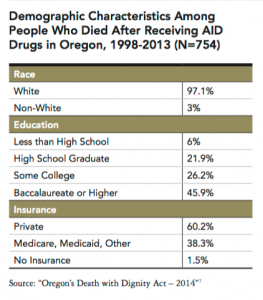Executive Summary
Terminally ill patients should have the option to request a physician assist them in ending their life. Only the patient knows what they are going through physically, mentally, and emotionally so why should we deprive them of aid in dying.
Why it is important
Aid in dying gives terminally ill patients another option in their end-of-life care. I have witnessed two very close family members die of aggressive cancers. They went from being fully functioning to losing the ability to eat or speak within a matter of weeks. By the end, they were given high doses of pain medication so they would not suffer. There is a concern that it is unethical for a physician to assist in ending a life, but the same can be said of allowing a person to suffer for 6 months. The top three reasons for requesting AID are “loss of autonomy” (87%), “loss of dignity” (80%), and “loss of the ability to enjoy the activities that make life worth living” (84%). As future social workers it is important that we advocate for the dignity and worth of all people.
Facts
- AID is currently legal in only 5 states (not including Illinois). Canada recently made it legal because they believe it is a human right.
- There are strict regulations that have to be followed when using AID. The current laws all have similar components.
-The patient has to be terminally ill and expected to die within 6 months
-The patient has to make 2 oral requests that are 15 days or more apart
-A written request that includes signatures from witnesses
-Mental health evaluation
-The physician has to provide the patient with information on all their options before they can choose to use AID
- One main concern is that vulnerable populations would use AID more frequently because of lack of education or funds for other end-of-life options.
- In Oregon in 2014 less than 100 people requested to use AID.
Conclusion
Aid in dying should be legal in all states for those that choose to use it. It is important to some terminally ill patients to die with dignity so we should provide them this right. There is no reason why they should have to move to a state that provides this option. With strict protocol and regulations, we can try to ensure AID is administered properly. Physicians should be trained to handle AID just like they are trained to address other medical issues.
You can help
Contact state representatives about the importance of the Illinois Patient Choices at End of Life Act.
Join and donate to Final Options Illinois an organization that supports legalizing AID in Illinois http://www.finaloptionsillinois.org/



